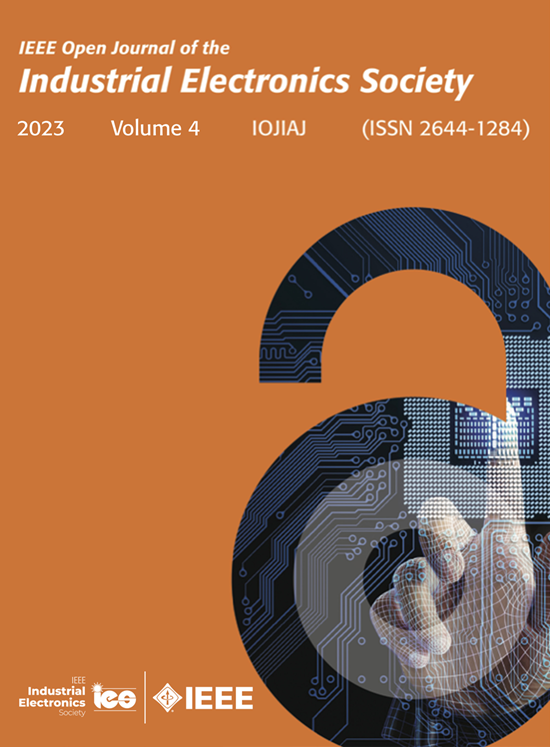Energy Efficiency Optimization Design for Cycle Position Servo PMSM Based on Operating Energy Consumption Model
IF 4.3
Q1 ENGINEERING, ELECTRICAL & ELECTRONIC
IEEE Open Journal of the Industrial Electronics Society
Pub Date : 2025-04-04
DOI:10.1109/OJIES.2025.3555606
引用次数: 0
Abstract
Motor efficient design is an important measure to reduce the energy consumption of servo motor system. Existing methods typically focus on optimizing the efficiency at specific operating points or the proportion of the high-efficiency region, making it difficult to quantify the matching of the position servo motor's periodic wide-domain operating conditions under trajectory planning. In this article, an energy efficiency optimization design method for position servo permanent magnet synchronous motor (PMSM) based on a cycle operating energy consumption model is proposed. First, the periodic operating states of PMSM under position trajectory planning are characterized by the speed-torque operating curve. A neural network mapping between PMSM full-domain dynamic losses and speed-torque-temperature is constructed based on finite element data. Combined with the physical analytical model of mechanical power and friction, a data-model driven precise model is established, enabling quantitative evaluation of the cycle energy consumption with different PMSM design schemes; then, taking cycle operating energy consumption and peak torque as optimization objectives, the optimal Latin hypercube sampling method is employed to generate finite element optimization data samples. Dimension reduction of design variables is performed through correlation analysis, followed by the establishment of a precise response surface model for optimization objectives and significant variables. The optimal design scheme after global optimization is quickly solved by the evolutionary algorithm. Finally, the effectiveness of the proposed method is verified through simulation and prototype experiments.基于运行能耗模型的循环位置伺服永磁同步电机能效优化设计
电机高效设计是降低伺服电机系统能耗的重要措施。现有方法主要关注特定工作点的效率优化或高效区域的比例优化,难以量化轨迹规划下位置伺服电机周期性宽域工况的匹配。提出了一种基于循环运行能耗模型的位置伺服永磁同步电机能效优化设计方法。首先,利用转速-转矩运行曲线表征了位置轨迹规划下永磁同步电机的周期性运行状态。基于有限元数据,构建了PMSM全域动态损耗与转速-转矩-温度之间的神经网络映射。结合机械动力和摩擦的物理解析模型,建立了数据模型驱动的精确模型,可以定量评价不同永磁同步电机设计方案下的循环能耗;然后,以循环运行能耗和峰值扭矩为优化目标,采用最优拉丁超立方体采样法生成有限元优化数据样本。通过相关分析对设计变量进行降维,建立优化目标和显著变量的精确响应面模型。采用进化算法快速求解全局优化后的最优设计方案。最后,通过仿真和样机实验验证了所提方法的有效性。
本文章由计算机程序翻译,如有差异,请以英文原文为准。
求助全文
约1分钟内获得全文
求助全文
来源期刊

IEEE Open Journal of the Industrial Electronics Society
ENGINEERING, ELECTRICAL & ELECTRONIC-
CiteScore
10.80
自引率
2.40%
发文量
33
审稿时长
12 weeks
期刊介绍:
The IEEE Open Journal of the Industrial Electronics Society is dedicated to advancing information-intensive, knowledge-based automation, and digitalization, aiming to enhance various industrial and infrastructural ecosystems including energy, mobility, health, and home/building infrastructure. Encompassing a range of techniques leveraging data and information acquisition, analysis, manipulation, and distribution, the journal strives to achieve greater flexibility, efficiency, effectiveness, reliability, and security within digitalized and networked environments.
Our scope provides a platform for discourse and dissemination of the latest developments in numerous research and innovation areas. These include electrical components and systems, smart grids, industrial cyber-physical systems, motion control, robotics and mechatronics, sensors and actuators, factory and building communication and automation, industrial digitalization, flexible and reconfigurable manufacturing, assistant systems, industrial applications of artificial intelligence and data science, as well as the implementation of machine learning, artificial neural networks, and fuzzy logic. Additionally, we explore human factors in digitalized and networked ecosystems. Join us in exploring and shaping the future of industrial electronics and digitalization.
 求助内容:
求助内容: 应助结果提醒方式:
应助结果提醒方式:


